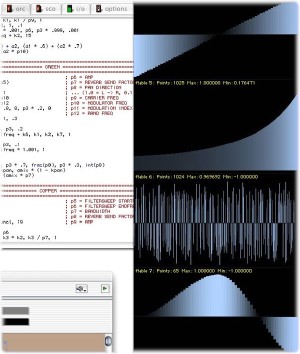 Geeky, powerful (if tricky to master), free — it’s Csound 5. This audio program, which can trace its lineage directly to the first ever digital audio synthesis tool, doesn’t get major upgrades that often. So the just-released version 5 upgrade is big news, if nothing else because it makes Csound interoperable with lots of other stuff. If you want the Csound synthesis tools working inside Pd, communicating with other apps via OSC and Jack, hosting VST plugins, acting as a VST or AudioUnit plugin itself, or working in tandem with the sound app you just coded yourself in Java or Python, now you can. Someone somewhere is excited by things like this, too, even if they’re meaningless to the rest of us: “SADIR SSDIR and INCDIR can now be a colon separated list of directories.” (For the masses? Nope. But a dedicated following has embraced it.)
Geeky, powerful (if tricky to master), free — it’s Csound 5. This audio program, which can trace its lineage directly to the first ever digital audio synthesis tool, doesn’t get major upgrades that often. So the just-released version 5 upgrade is big news, if nothing else because it makes Csound interoperable with lots of other stuff. If you want the Csound synthesis tools working inside Pd, communicating with other apps via OSC and Jack, hosting VST plugins, acting as a VST or AudioUnit plugin itself, or working in tandem with the sound app you just coded yourself in Java or Python, now you can. Someone somewhere is excited by things like this, too, even if they’re meaningless to the rest of us: “SADIR SSDIR and INCDIR can now be a colon separated list of directories.” (For the masses? Nope. But a dedicated following has embraced it.)
Now, okay, I’ll admit, I’ve used Csound in the past and have been known to complain about it. But for those who can hack the learning curve, it offers some great potential, and the price is right. And the hard-core connections to other environments and languages mean you can combine tools. One thing’s for sure: Csound has been evolving from what most of us once knew it as, because now you can perform magical tasks like use OpenGL 3D graphics in it.
As always, Csounds.com is your source, for the software, and plenty of resources for learning it, even if you’re a complete newbie to all of this.
Pictured: Proof by Matt Ingalls that Csound isn’t just about text interfaces.
Previously:
Electric Violins, IBM Mainframes, and Playboy (A brief history of Max Mathews’ contributions to digital audio synthesis, from its very inception to Csound)